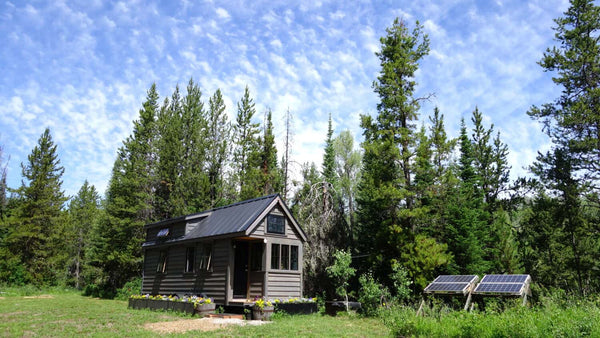In 2023, Canada experienced its worst calamity ever, with over 4,000 fires burning more than 10 million hectares of land, an area larger than Portugal. The smoke from these fires reached as far as Europe, affecting the air quality and health of millions of people. But what caused this disaster, and what preventive measures can help you survive?
In this article, we will explore the causes and effects of Canadian wildfires. Moreover, we will also discuss how you can get prepared and protect yourself with the help of solar power backups during these hard times. Let’s begin.
Canadian Wildfire Background
To better understand the ins and outs of Canadian wildfires, it’s first important to know about its background as given below:
History and Impact of Wildfires in Canada
Wildfires are a natural and important part of the forest ecosystem as they promote ecological restoration, biodiversity, and habitat diversity. However, they can also have devastating consequences for human lives, property and the environment.
Nine percent of the world’s forests are in Canada, which experiences about 7,300 forest fires each year. The region has been experiencing intense wildfires since the 1950s. And the peak year for them was 1989, when there were roughly 12,000 wildfires recorded.
However, the number, intensity and area burned by wildfires have been changing over time due to various factors, such as climate change and human activities.
To add on, these wildfires can have significant economic, social and environmental impacts. Some of these include:
Loss of life and property: Wildfires can threaten human lives and destroy homes, businesses and infrastructure.
Air quality and health: Wildfires can produce large amounts of smoke and pollutants that can affect air quality and human health. Exposure to wildfire smoke can cause respiratory problems, eye irritation, headaches and other symptoms in living beings.
Climate change and feedback: They can contribute to climate change by releasing greenhouse gases and aerosols into the atmosphere. This also aggravates the issue of global warming.
Biodiversity and ecosystem services: Wildfires can affect biodiversity and ecosystem services by altering habitat structure, species composition and ecological processes. They can also affect ecosystem services such as water quality and quantity, soil fertility and carbon storage.

Size and Severity of Canadian Wildfires in 2023
The year 2023 has been the worst wildfire season in Canadian history, affecting all thirteen provinces and territories. Some of the most affected regions are Quebec, Ontario, and Nova Scotia, where hundreds of fires have forced evacuations, threatened Indigenous communities and culture and challenged firefighting efforts.
As of July 19, 4,285 fires had burned 10,971,638 hectares (27,111,508 acres), more than three percent of the entire forest area of Canada. Moreover, of the 885 active wildfires, 562 were deemed “out of control.”
What Caused the Canadian Wildfires?
The Canadian wildfires have been caused by a combination of factors, including:
1. Climate change
Climate change has increased the temperature and reduced the precipitation in many parts of Canada, creating drier and warmer conditions that make vegetation more flammable and prone to ignition.
It has also increased the frequency and intensity of extreme weather events, such as heat waves, droughts, and wind storms, that can trigger or spread fires.
2. Drought
Drought is a prolonged period of low or no rainfall that reduces the moisture content of the soil and vegetation. A long period of drought makes fires more likely to start and makes them equally difficult to extinguish.
As Canada has experienced severe and widespread droughts in recent years, especially in the western provinces, this has caused an increase in wildfires in the country.
3. Wind
The wind is a natural force that can affect the direction, speed, and spread of fires. It can also carry embers or sparks from one fire to another, creating new ignitions or spot fires.
Moreover, winds can also increase the oxygen supply to the fire, making it burn hotter and faster. Since Canada experiences strong and gusty winds, it has led to aggravation of the wildfires.
4. Lack of controlled burns
Controlled burns are intentional fires that are set under controlled conditions to reduce the amount of fuel on the forest floor, such as dead wood and grasses. These burns can help prevent or reduce the severity of wildfires by creating fire breaks and reducing fire intensity.
Canada has largely stopped performing controlled burns due to regulatory barriers, public opposition, and safety concerns. This has resulted in an accumulation of fuel on the forest floor that can feed larger and more dangerous fires.
Analysis of Wildfires In Canada In 2023
Let’s analyze the case of the Texas Creek Fire in southern British Columbia, which was ignited by a lightning strike on May 7. It became Canada's most destructive wildfire, destroying over 2,000 structures and displacing 30,000 people by July 19.
The fire spread rapidly under hot and dry conditions, fueled by dense stands of pine trees that were killed by mountain pine beetles. It created firestorms, pyro cumulonimbus clouds, and fire tornadoes.
Several communities and infrastructure, including the city of Kelowna, the Okanagan Valley wine region, and the Trans-Canada Highway, were under threat. The fire also produced large amounts of smoke that degraded air quality and affected human health in British Columbia and surrounding provinces.
The Forest Service had to rely on external assistance from other provinces, territories, and countries to fight the fire. This exposed gaps in emergency management policies and practices, especially regarding evacuation orders and alerts.
Get Prepared For a Wildfire

Wildfires are a serious threat to human safety and property. Therefore, we need to be prepared all the time in this atmosphere of climate change for a wildfire. Some considerations to handle this situation include:
- Check the fire risk and follow the rules in your area
- Clear away any flammable materials around your home
- Have an emergency plan and kit with water, food, medicine, documents, and a radio
- Stay informed of the fire situation and evacuation orders or alerts
- Evacuate if ordered or stay indoors if not
Before completing your emergency kit, you should back up your house power, too, as power outages are very common during wildfires. For this, you can get a BLUETTI AC300 UPS Box from BLUETTI Power.

This UPS Box can connect your AC300 or EP500 power station to your home’s electrical panel, allowing you to use it as backup power for the whole house. The UPS Box can automatically switch between grid power and power station power. So, you can easily install it to protect your appliances from power cuts and surges.
In addition to this, one of the main items in your emergency kit should be a portable power station that can run your devices and appliances. For that, the BLUETTI AC200P Portable Power Station from BLUETTI Power can be a good choice.
It is a powerful solar generator that can provide 2000W of power and 2000Wh of battery. You can run fridges, laptops, TVs, fans, lights, and more using this generator. Additionally, the device comes with output ports, so you can recharge it with solar panels, wall outlets, or car chargers.
However, even if you have a solar panel, you would still need an energy source to recharge it. The BLUETTI PV200 Solar Panel is a popular choice for this purpose.
It is a foldable and portable solar panel that can produce 200W of power. You can fully charge the AC200P in about 3.5 hours in good sunlight with it. Also, it has kickstands and handles for easy setup and transport. Additionally, the solar panel works with the AC200P and other power stations with MC4 connectors.
By having these products from Bluetttipower.ca in your emergency kit, you can be ready for a wildfire and have reliable and clean power for your needs.
Final Thoughts
The Canadian wildfires are a part of our new climate reality, and they pose a serious challenge to our safety, health, and environment. To cope with this challenge, we need to be prepared and resilient, as well as take action to reduce our impact and mitigate the effects of climate change.
One of the ways we can do that is by using solar power, which is a clean and renewable energy source that can provide us with backup power during emergencies.
The products from BLUETTI power are designed to help us harness the power of the sun and use it for our various needs. They are powerful, versatile, portable, and easy to use. Moreover, they can help us stay connected and informed during a wildfire, as well as enjoy the benefits of solar power in our daily lives.
So, make sure to put in effort to reduce your carbon footprint and keep your emergency kit ready to avoid sudden threats.
FAQs:
1. When did Canada fires start in 2023?
The 2023 wildfire season in Canada began with initial fires in March, but it intensified significantly in June as hundreds of wildfires broke out nationwide.
2. What provinces have the most wildfires in Canada?
As of July 19, the provinces with the most wildfires in Canada are
- British Columbia (372)
- Alberta (121)
- Quebec (108)
- Ontario (78)
- Nova Scotia (53)
3. How do you prepare for a wildfire in Canada?
To prepare for a wildfire in Canada, take proactive steps to safeguard yourself. Make sure the area around your home is free from flammable material. Also, have all emergency materials ready to go. Furthermore, familiarise yourself with evacuation procedures and routes. You must also keep essential fire-fighting equipment on hand where it is quickly approachable.
4. How can we help Canadian wildfires?
To help Canadian wildfires, you can do the following: 4
- Donate to reputable organizations like Canadian Red Cross or local food banks
- Volunteer for recovery efforts or offer assistance to evacuees
- Follow fire prevention tips, such as avoiding outdoor burning, disposing of cigarettes properly, and reporting any signs of fire or smoke
- Raise awareness and advocate for action on climate change
5. How can you protect yourself from Canadian wildfire smoke?
To protect yourself from Canadian wildfire smoke:
- Check AQI and avoid outdoor activities during high or unhealthy levels
- Wear a well-fitted N95 or KN95 mask outdoors; cloth or surgical masks won't suffice
- Keep indoor air clean with HEPA-filter air purifiers, close windows, and avoid indoor pollution sources
- Seek medical attention if experiencing smoke exposure symptoms, especially if you have underlying health conditions




